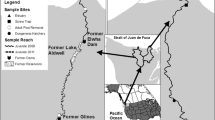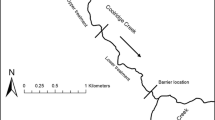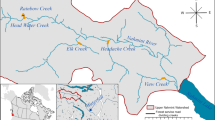Abstract
Coldwater fishes in streams, such as brook trout (Salvelinus fontinalis), typically are headwater specialists that occasionally expand distributions downstream to larger water bodies. It is unclear, however, whether larger streams function simply as dispersal corridors connecting headwater subpopulations, or as critical foraging habitat needed to sustain large mobile brook trout. Stable isotopes (δ13C and δ15N) and a hierarchical Bayesian mixing model analysis was used to identify brook trout that foraged in main stem versus headwater streams of the Shavers Fork watershed, West Virginia. Headwater subpopulations were composed of headwater and to a lesser extent main stem foraging individuals. However, there was a strong relationship between brook trout size and main stem prey contributions. The average brook trout foraging on headwater prey were limited to 126 mm standard length. This size was identified by mixing models as a point where productivity support switched from headwater to main stem dependency. These results, similar to other studies conducted in this watershed, support the hypothesis that productive main stem habitat maintain large brook trout and potentially facilitates dispersal among headwater subpopulations. Consequently, loss of supplementary main stem foraging habitats may explain loss of large, mobile fish and subsequent isolation of headwater subpopulations in other central Appalachian watersheds.



Similar content being viewed by others
References
Adams SB, Frissell CA, Rieman BE (2000) Movements of nonative brook trout in relation to stream channel slope. Trans Am Fish Soc 129:623–638
Aunins AW, Petty JT, King TL, Schilz M, Mazik PM (2015) Genetic differentiation and complex metapopulation structure of an Appalachian brook trout population. Conserv Genet 16:15–29
Barton DR, Taylor WD, Biette RM (1985) Dimensions of riparian buffer strips required to maintain trout habitat in southern Ontario streams. North Am J Fish Manag 5(3A):364–378
Bond AL, Diamond AW (2011) Recent Bayesian stable-isotope mixing models are highly sensitive to variation in discrimination factors. Ecol Appl 21:1017–1023
Bopp JA (2002) Combined effects of water chemistry, canopy cover, and stream size on benthic macroinvertebrates along a central Appalachian stream continuum. Thesis, West Virginia University, Morgantown, West Virginia, USA
Cross BK, Bozek MA, Mitro MG (2013) Influences of riparian vegetation on trout stream temperatures in central Wisconsin. North Am J Fish Manag 33:682–692
DeNiro MJ, Epstein S (1978) Influence of diet on the distribution of carbon isotopes in animals. Geochim Cosmochim Acta 42:495–506
DeNiro MJ, Epstein S (1981) Influence of diet on the distribution of nitrogen isotopes in animals. Geochim Cosmochim Acta 45:341–351
Dunning JB, Danielson BJ, Pulliam HR (1992) Ecological processes that affect populations in complex landscapes. Oikos 65:169–175
England LE, Rosemond AD (2004) Small reductions in forest cover weaken terrestrial-aquatic linkages in headwater streams. Freshw Biol 49:721–734
Fausch KD, Torgersen CE, Baxter CV, Li HW (2002) Landscapes to riverscapes: bridging the gap between research and conservation of stream fishes a continuous view of the river is needed to understand how processes interacting among scales set the context for stream fishes and their habitat. Bioscience 52:483–498
Finlay JC (2001) Stable-carbon-isotope ratios of river biota: implications for energy flow in lotic food webs. Ecology 82:1052–1064
Finlay JC, Doucett RR, McNeely C (2010) Tracing energy flow in stream food webs using stable isotopes of hydrogen. Freshw Biol 55:941–951
Francis TB, Schindler DE, Holtgrieve GW, Larson ER, Scheuerell MD, Semmens BX, Ward EJ (2011) Habitat structure determines resource use by zooplankton in temperate lakes. Ecol Lett 14:364–372
Gelman A, Rubin DB (1992) Inference from iterative simulation using multiple sequences. Stat Sci 7:457–511
Haddad NM (1999) Corridor and distance effects on interpatch movements: a landscape experiment with butterflies. Ecol Appl 9:612–622
Hanski I (1998) Metapopulation dynamics. Nature 396:41–49
Hudy M, Thieling TM, Gillespie N, Smith EP (2008) Distribution, status, and land use characteristics of subwatersheds within the native range of brook trout in the eastern United States. North Am J Fish Manag 28:1069–1085
Huntsman BM, Petty JT (2014) Density-dependent regulation of brook trout population dynamics along a core-periphery distribution gradient in a central Appalachian watershed. PLoS One 9:e91673. doi:10.1371/journal.pone.0091673
Jackson AL, Inger R, Bearhop S, Parnell A (2009) Erroneous behaviour of MixSIR, a recently published Bayesian isotope mixing model: a discussion of Moore & Semmens (2008). Ecol Lett 12:E1–E5
Jardine TD, Gray MA, McWilliam SM, Cunjak RA (2005) Stable isotope variability in tissues of temperate stream fishes. Trans Am Fish Soc 134:1103–1110
Jardine TD, Kidd KA, Fisk AT (2006) Applications, considerations, and sources of uncertainty when using stable isotope analysis in ecotoxicology. Environ Sci Technol 40:7501–7511
Jardine TD, Hunt RJ, Pusey BJ, Bunn SE (2011) A non-lethal sampling method for stable carbon and nitrogen isotope studies of tropical fishes. Mar Freshw Res 62:83–90
Kanno Y, Vokoun JC, Letcher BH (2011) Sibship reconstruction for inferring mating systems, dispersal and effective population size in headwater brook trout (Salvelinus fontinalis) populations. Conserv Genet 12:619–628
Kelson SJ, Kapuscinski AR, Timmins D, Ardren WR (2015) Fine-scale genetic structure of brook trout in a dendritic stream network. Conserv Genet 16:31–42. doi:10.1007/s10592-014-0637-5
King AJ, Humphries P, Lake PS (2003) Fish recruitment on floodplains: the roles of patterns of flooding and life history characteristics. Can J Fish Aquat Sci 60:773–786
Kruschke J (2014) Doing Bayesian data analysis: a tutorial with R, JAGS, and Stan, 2nd edn. Academic Press, London
Levins R (1969) Some demographic and genetic consequences of environmental heterogeneity for biological control. Bull ESA 15:237–240
Liller ZW (2006) Spatial variation in brook trout (Salvelinus fontinalis) population dynamics and juvenile recruitment potential in an Appalachian watershed. Thesis, West Virginia University, Morgantown, West Virginia, USA
Limm MP, Marchetti MP (2009) Juvenile Chinook salmon (Oncorhynchus tshawytscha) growth in off-channel and main-channel habitats on the Sacramento River, CA using otolith increment widths. Environ Biol Fishes 85:141–151
Logan JM, Jardine TD, Miller TJ, Bunn SE, Cunjak RA, Lutcavage ME (2008) Lipid corrections in carbon and nitrogen stable isotope analyses: comparison of chemical extraction and modelling methods. J Anim Ecol 77:838–846
McClurg SE, Petty JT, Mazik PM, Clayton JL (2007) Stream ecosystem response to limestone treatment in acid impacted watersheds of the Allegheny Plateau. Ecol Appl 17:1087–1104
McCutcheon JH, Lewis WM, Kendall C, McGrath CC (2003) Variation in trophic shift for stable isotope ratios of carbon, nitrogen, and sulphur. Oikos 102:378–390
Merritt RW, Cummins KW, Berg MB (2008) An Introduction to the Aquatic Insects of North America, 4th edn. Kendall/Hunt, Dubuque
Minagawa M, Wada E (1984) Stepwise enrichment of 15 N along food chains: further evidence and the relation between δ15N and animal age. Geochim Cosmochim Acta 48:1135–1140
Moore JW, Semmens BX (2008) Incorporating uncertainty and prior information into stable isotope mixing models. Ecol Lett 11:470–480
Morinville GR, Rasmussen JB (2006) Does life-history variability in salmonids affect habitat use by juveniles? A comparison among streams open and closed to anadromy. J Anim Ecol 75:693–704
Myers DJ, Whitledge GW, Whiles MR (2012) Evaluation of δD and δ18O as natural markers of invertebrate source environment and dispersal in the middle Mississippi River-floodplain ecosystem. River Res Appl 28:135–142
Neville HM, Dunham JB, Peacock MM (2006) Landscape attributes and life history variability shape genetic structure of trout populations in a stream network. Landsc Ecol 21:901–916
Petty JT, Merriam EP (2012) Brook trout restoration. Nat Educ 3:17
Petty JT, Freund J, Lamothe P, Mazik PM (2001) Quantifying instream habitat in the upper Shavers Fork basin at multiple spatial scales. Proc Annu Conf Southeast Assoc Fish Wildl Agencies 55:81–94
Petty JT, Lamothe PJ, Mazik PM (2005) Spatial and seasonal dynamics of brook trout populations inhabiting a central Appalachian watershed. Trans Am Fish Soc 134:572–587
Petty JT, Hansbarger JL, Huntsman BM, Mazik PM (2012) Brook trout movement in response to temperature, flow, and thermal refugia within a complex Appalachian riverscape. Trans Am Fish Soc 141:1060–1073
Petty JT, Thorne D, Huntsman BM, Mazik PM (2014) The temperature-productivity squeeze: constraints on brook trout growth along an Appalachian river continuum. Hydrobiologia 727:151–166
Phillips DL, Eldridge PM (2006) Estimating the timing of diet shifts using stable isotopes. Oecologia 147:195–203
Phillips DL, Inger R, Bearhop S, Jackson AL, Moore JW, Parnell A, Semmens BX, Ward EJ (2014) Best practices for use of stable isotope mixing models in food-web studies. Can J Zool 92:823–835
Pope SE, Fahrig L, Merriam HG (2000) Landscape complementation and metapopulation effects on leopard frog populations. Ecology 81:2498–2508
Poplar-Jeffers IO, Petty JT, Anderson JT, Kite SJ, Strager MP, Fortney RH (2009) Culvert replacement and stream habitat restoration: implications from brook trout management in an Appalachian watershed, USA. Restor Ecol 17:404–413
Post DM (2002) Using stable isotopes to estimate trophic position: models, methods, and assumptions. Ecology 83:703–718
Post DM, Layman CA, Arrington DA, Takimoto G, Quattrochi J, Montana CG (2007) Getting to the fat of the matter: models, methods and assumptions for dealing with lipids in stable isotope analyses. Oecologia 152:179–189
Pulliam HR (1988) Sources, sinks, and population regulation. Am Nat 132:652–661
Rasmussen JB, Trudeau V, Morinville G (2009) Estimating the scale of fish feeding movements in rivers using δ13C signature gradients. J Anim Ecol 78:674–685
Ricketts TH (2001) The matrix matters: effective isolation in fragmented landscapes. Am Nat 158:87–99
Rieman BE, Dunham JB (2000) Metapopulations and salmonids: a synthesis of life history patterns and empirical observations. Ecol Freshw Fish 9:51–64
Robillard MM, Casselman JM, McLaughlin RL, Mackereth RW (2011) Alternative growth histories in populations of Lake Superior brook trout: Critical support for partial migration. Biol Conserv 144:1931–1939
Rypel AL, Pounds KM, Findlay RH (2012) Spatial and temporal trade-offs by bluegills in floodplain river ecosystems. Ecosystems 15:555–563
Schlosser IJ (1995) Critical landscape attributes that influence fish population dynamics in headwater streams. Hydrobiologia 303:71–81
Schlosser IJ (1998) Fish recruitment, dispersal, and trophic interactions in a heterogeneous lotic environment. Oecologia 113:260–268
Schooley RL, Branch LC (2009) Enhancing the area-isolation paradigm: habitat heterogeneity and metapopulation dynamics of a rare wetland mammal. Ecol Appl 19:1708–1722
Semmens BX, Ward EJ, Moore JW, Darimont CT (2009) Quantifying inter-and intra-population niche variability using hierarchical Bayesian stable isotope mixing models. PLoS One 4:e6187. doi:10.1371/journal.pone.0006187
Sharma S, Sack A, Adams JP, Vesper DJ, Capo R, Hartstock A, Edenborn HM (2013) Isotopic evidence of enhanced carbonate dissolution at a coal mine drainage site in Allegheny County, Pennsylvania USA. Appl Geochem 29:32–42
Stock BC, Semmens BX (2013) MixSIAR GUI user manual: version 1.0. https://github.com/brianstock/MixSIAR/blob/master/MixSIAR%20GUI%20User%20Manual%201.0.pdf
Suzuki KW, Kasai A, Nakayama K, Tanaka M (2005) Differential isotopic enrichment and half-life among tissues in Japanese temperate bass (Lateolabrax japonicus) juveniles: implications for analyzing migration. Can J Fish Aquat Sci 62:671–678
Sweeting CJ, Polunin NVC, Jennings S (2006) Effects of chemical lipid extraction and arithmetic lipid correction on stable isotope ratios of fish tissues. Rapid Commun Mass Spectrom 20:595–601
Thériault V, Dunlop ES, Dieckmann U, Bernatchez L, Dodson JJ (2008) The impact of fishing-induced mortality on the evolution of alternative life-history tactics in brook charr. Evol Appl 1:409–423
Tincher M (2013) Modeling water temperatures and brook trout (Salvelinus fontinalis) growth potential within a complex Appalachian riverscape. Thesis, West Virginia University, Morgantown, West Virginia, USA
Vander Zanden M, Rasmussen JB (2001) Variation in δ15N and δ13C trophic fractionation: implications for aquatic food web studies. Limnol Oceanogr 46:2061–2066
Vanderklift MA, Ponsard S (2003) Sources of variation in consumer-diet δ15N enrichment: a meta-analysis. Oecologia 136:169–182
Vannote RL, Minshall GW, Cummins KW, Sedell JR, Cushing CE (1980) The river continuum concept. Can J Fish Aquat Sci 37:130–137
Venarsky MP, Huntsman BM, Huryn AD, Benstead JP, Kuhajda BR (2014) Quantitative food web analysis supports the energy-limitation hypothesis in cave stream ecosystems. Oecologia 176:859–869
Vogel JC (1993) Variability of carbon isotope fractionation during photosynthesis. In: Ehleringer JR, Hall AE, Farquhar GD (eds) Stable isotopes and plant carbon-water relations. Academic Press, San Diego, pp 29–46
Wagner T, Deweber JT, Detar J, Sweka JA (2013) Landscape-scale evaluation of asymmetric interactions between brown trout and brook trout using two-species occupancy models. Trans Am Fish Soc 142:353–361
Whiteley AR, Coombs JA, Hudy M, Robinson Z, Colton AR, Nislow KH, Letcher BH (2013) Fragmentation and patch size shape genetic structure of brook trout populations. Can J Fish Aquat Sci 70:678–688
Acknowledgments
We would like to thank the WV Department of Natural Resources for gate access and funding, as well as the US Fish and Wildlife Service and US Geological Survey for funding (grant NRAC 387). Partial support for this work was also provided by the National Science Foundation’s early career instrumentation grant (EAR-1205596) to S.S. We would like to thank the many members of the J.T.P lab for field assistance and Donna Hartman for administrative help. We would also like to thank Nate Taylor, Christina Slover, Bethany Meier, Andrea Sack, Dr. Ajaya Warrier, Travis Wilson and Darren Wood for field and lab assistance. All applicable institutional and/or national guidelines for the care and use of animals were followed. Early drafts of this manuscript were greatly improved by comments from Dr. Mike Venarsky, Dr. Jonathan Benstead, and Dr. Colleen Caldwell.
Author contribution statement
BMH conceived and designed the study, conducted fieldwork, performed statistical analysis, and wrote the manuscript. JTP conceived and designed the study, and wrote the manuscript. SS processed stable isotope data and wrote the manuscript. ERM conducted fieldwork and processed stable isotope data.
Author information
Authors and Affiliations
Corresponding author
Additional information
Communicated by Joel Trexler.
Electronic supplementary material
Below is the link to the electronic supplementary material.
442_2016_3676_MOESM1_ESM.docx
Fig. A1 Isospace of brook trout isotopic signatures with sources corrected by two separate trophic enrichment factors. The “Tradition” trophic enrichment factor represents a 3.4 ‰ enrichment in nitrogen and a 1 ‰ enrichment in carbon. The “McCutchen” trophic enrichment factor represents enrichment specific to brook trout, where nitrogen is enriched by 3.8 ‰ and carbon is enriched by 3.3 ‰ (DOCX 93 kb)
Rights and permissions
About this article
Cite this article
Huntsman, B.M., Petty, J.T., Sharma, S. et al. More than a corridor: use of a main stem stream as supplemental foraging habitat by a brook trout metapopulation. Oecologia 182, 463–473 (2016). https://doi.org/10.1007/s00442-016-3676-4
Received:
Accepted:
Published:
Issue Date:
DOI: https://doi.org/10.1007/s00442-016-3676-4




